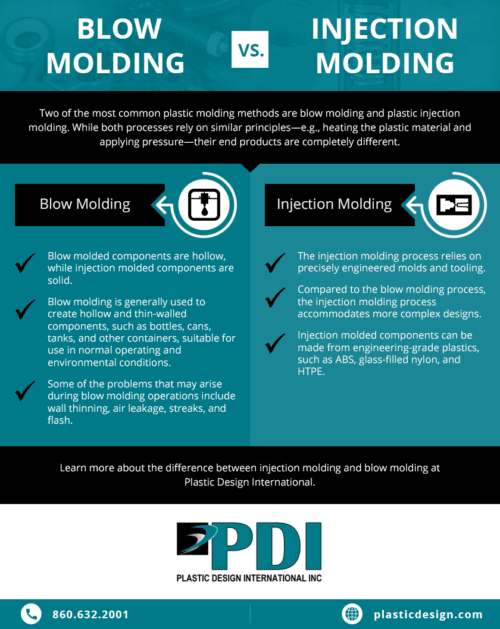 Plastic molding is a manufacturing process used to produce a wide range of parts and products from plastic materials. Two of the most common plastic molding methods are blow molding and plastic injection molding. While both processes rely on similar principles—e.g., heating the plastic material and applying pressure—their end products are completely different; blow molded components are hollow, while injection molded components are solid.
Plastic molding is a manufacturing process used to produce a wide range of parts and products from plastic materials. Two of the most common plastic molding methods are blow molding and plastic injection molding. While both processes rely on similar principles—e.g., heating the plastic material and applying pressure—their end products are completely different; blow molded components are hollow, while injection molded components are solid.
The following blog post provides greater detail regarding the differences between the two processes.
What Is Blow Molding?
The blow molding process is similar to glassblowing. A tube of plastic is heated and pumped with air until it turns into a hot plastic balloon (i.e., parison). The parison is then enclosed within a product mold. Air continues to flow into the parison until it expands and conforms to the shape of the mold, forming the desired part or product. Once the component has cooled, it is ejected from the mold.
This molding method has few engineering applications. It is generally used to create hollow and thin-walled components, such as bottles, cans, tanks, and other containers, suitable for use in normal operating and environmental conditions. The one-piece construction of these components eliminates the need for subsequent assembly processes, resulting in simple and fast production operations. These qualities, combined with relatively cheap machinery, result in low overall production costs.
During blow molding operations, it is important to keep in mind quality control measures. As many blow molded components feature thin walls, designers and engineers must identify the right wall thickness to ensure the component has the structural shape and integrity needed for the application. Some of the problems that may arise during operations include wall thinning, air leakage, streaks, and flash.
What is Injection Molding?
The injection molding process relies on precisely engineered molds and tooling. During operations, liquid plastic is injected into the mold (typically made from aluminum or stainless steel) at high pressures. Once the material is sufficiently cooled, it maintains the shape of the mold and, consequently, the desired part or product. At this point, it is ejected from the mold.
This molding method is used to create solid components. It is ideal for fulfilling high-volume orders of small and precise plastic pieces, such as handles, housings, and toys.
Compared to the blow molding process, the injection molding process accommodates more complex designs. Additionally, it can be used to create parts and products for demanding applications (e.g., high temperatures or stresses). For these situations, the components are generally made from engineering-grade plastics, such as ABS, glass-filled nylon, and HTPE.
Contact the Plastic Molding Experts at Plastic Design Today
Both blow molding and injection molding play a critical role in the manufacture of a wide range of plastic parts and products. If you’re looking for an injection molding partner for your next project, turn to the experts at Plastic Design today.
At Plastic Design International, Inc., we’ve provided custom plastic injection molding solutions for over 40 years. We utilize state-of-the-art technology, including automated conveyors, robotic sprue pickers, and CMM equipment, and maintain ISO certification to ensure the molded products we deliver fully meet our customers’ specifications and standards.
To learn more about our injection molding capabilities or discuss your project requirements with one of our representatives, contact us or request a quote today.


Comments are closed